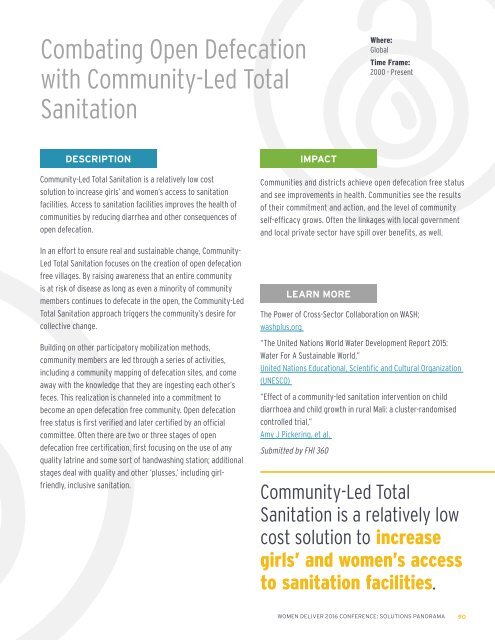Solutions Panorama
A collection of 100 programs, initiatives, and strategies that were shared at the Women Deliver 2016 Conference.
A collection of 100 programs, initiatives, and strategies that were shared at the Women Deliver 2016 Conference.
Create successful ePaper yourself
Turn your PDF publications into a flip-book with our unique Google optimized e-Paper software.
Combating Open Defecation<br />
with Community-Led Total<br />
Sanitation<br />
Where:<br />
Global<br />
Time Frame:<br />
2000 - Present<br />
DESCRIPTION<br />
Community-Led Total Sanitation is a relatively low cost<br />
solution to increase girls’ and women’s access to sanitation<br />
facilities. Access to sanitation facilities improves the health of<br />
communities by reducing diarrhea and other consequences of<br />
open defecation.<br />
In an effort to ensure real and sustainable change, Community-<br />
Led Total Sanitation focuses on the creation of open defecation<br />
free villages. By raising awareness that an entire community<br />
is at risk of disease as long as even a minority of community<br />
members continues to defecate in the open, the Community-Led<br />
Total Sanitation approach triggers the community’s desire for<br />
collective change.<br />
Building on other participatory mobilization methods,<br />
community members are led through a series of activities,<br />
including a community mapping of defecation sites, and come<br />
away with the knowledge that they are ingesting each other’s<br />
feces. This realization is channeled into a commitment to<br />
become an open defecation free community. Open defecation<br />
free status is first verified and later certified by an official<br />
committee. Often there are two or three stages of open<br />
defecation free certification, first focusing on the use of any<br />
quality latrine and some sort of handwashing station; additional<br />
stages deal with quality and other ‘plusses,’ including girlfriendly,<br />
inclusive sanitation.<br />
IMPACT<br />
Communities and districts achieve open defecation free status<br />
and see improvements in health. Communities see the results<br />
of their commitment and action, and the level of community<br />
self-efficacy grows. Often the linkages with local government<br />
and local private sector have spill over benefits, as well.<br />
LEARN MORE<br />
The Power of Cross-Sector Collaboration on WASH;<br />
washplus.org<br />
“The United Nations World Water Development Report 2015:<br />
Water For A Sustainable World,”<br />
United Nations Educational, Scientific and Cultural Organization<br />
(UNESCO)<br />
“Effect of a community-led sanitation intervention on child<br />
diarrhoea and child growth in rural Mali: a cluster-randomised<br />
controlled trial,”<br />
Amy J Pickering, et al.<br />
Submitted by FHI 360<br />
Community-Led Total<br />
Sanitation is a relatively low<br />
cost solution to increase<br />
girls’ and women’s access<br />
to sanitation facilities.<br />
WOMEN DELIVER 2016 CONFERENCE: SOLUTIONS PANORAMA 90



